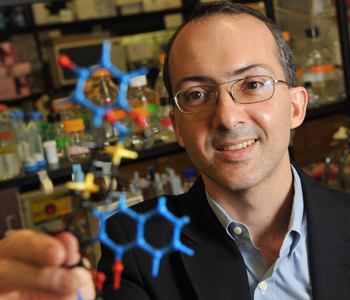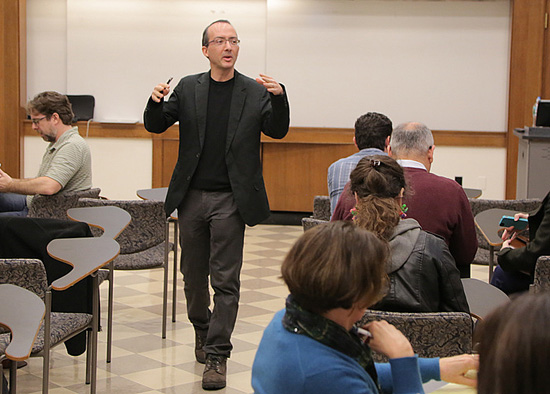Flipping the Biochemistry Classroom: Making Room for Real-World Problem Solving

“First,” said Stockwell, “many students come to class without doing the reading in advance, which makes it difficult to build upon that material. Second, a large fraction of students choose not to attend class at all, since I post the lecture notes for them. And third, some students each year just don’t seem to learn the material well in the traditional format.”
Stockwell had heard the buzz around “flipping the classroom” and was curious about how it worked. Flipping the classroom is a teaching technique where the typical lecture and the student work are reversed. Students are assigned to watch a recorded lecture prior to class. With the lecture content covered before class, classroom time can be used differently. Instructors can use the freed-up class time for discussion, group work, or solving problems.
After a number of meetings during the summer where Stockwell and CCNMTL staff hashed out the goals and objectives for his fall course, it became clear what Stockwell was after: he wanted his students better prepared; he wanted them more engaged in class discussions; and he wanted them to tackle real-world biochemistry problems. We then set out to redesign the course to meet his needs and to get his students thinking and problem solving in a new way. Here is a step-by-step description of the course redesign.
Step 1: Record Lecture Videos
Stockwell used two applications to construct his video lectures: PowerPoint and ScreenFlow. Weekly slide presentations were first built with PowerPoint. Then, he simulated a presentation while recording a voiceover using the video recording application ScreenFlow. The finished video was uploaded to YouTube. Once on YouTube, the video was embedded into the syllabus section of the learning management system (LMS). Students simply had to go to the course’s syllabus page and watch him discussing the weekly lecture material.
“The students really liked the videos and asked for even more. I didn’t expect them to be so popular,” said Stockwell.

Step 2: Lecture Quizzes
Once Stockwell had digitized his lecture material, he had to make sure that the students would watch the video lectures prior to class. That problem led to step 2 - the lecture quiz.
Stockwell created a series of short quizzes directly related to the video material and made them count as part of the course grade. A link to the quizzes was placed underneath the video player on the syllabus page—adopting an effective tactic from CCNMTL’s experiments with MOOCs (massive open online courses). Most students took the quiz right after watching the video, which was what Stockwell was hoping for. The quizzes ensured that most of the students would be prepared for the next day’s live in-class lecture.
Step 3a: Class Lecture
With a majority of students now prepped and ready for his live lecture, Stockwell was able to go deeper and in new directions with his course content. Most teachers wish that they would have more time to explain their content and thoughtfully and critically discuss why the material is so important. Strict classroom time constraints, however, often make that difficult. By digitizing much of the fundamental lecture content for viewing outside of the classroom, Stockwell was able to expound in class on topics that he considered paramount for a beginning biochemistry student.
Stockwell also incorporated a wide array of research articles, again taking advantage of the additional time he was able to generate. This allowed students to get a better understanding of the field and allowed Stockwell to speak to his students as both a researcher and a teacher.

Step 3b: Class Polling
During his live lecture, Stockwell incorporated a live polling service called Socrative that uses mobile devices—smartphones or tablets—which most students bring to class anyway. He also had some extra iPads brought into the classroom, just in case any students needed a device. He prepared a series of questions that he would pose to the class and receive anonymous responses in real-time displayed in the front of the class as a graph or chart.
This anonymous polling strategy allowed students to answer questions safely, without the fear of being wrong in front of peers. The collected responses would cue his next step in the live lecture. For example, he would revisit a difficult topic or speed up if everyone was with him. Polling became the engagement tool he was looking for; discussions became livelier, and students participated and asked more questions than ever before.
“Making questions and asking them in class was pretty simple, and broke up the lecture to make it more interactive, which also gave me a chance to organize my thoughts,” Stockwell remarked.
Step 4a: Creating Student Groups
Class discussions were only a part Stockwell’s plan for establishing community and collaboration. The other way was through group work. He wanted to use group work, which had a powerful effect on him during his college years. “One of my most memorable college courses was an organic chemistry course in which I worked with a small team to solve challenging homework problems - I remember in one problem, we 'discovered' a reaction we had never seen before, and it was an incredible moment for our group to share.”
Stockwell's class of 185 students was divided into groups of five. Because the redesign was implemented at the start of the semester, it was difficult to group students by their knowledge of the material, so Stockwell let students form groups on their own. If a student could not find a group, only then did he intercede and place him or her in an established group (if the group had less than 5 members). Using group work proved to be a big success.
“I was surprised how much I learned about the students’ thinking by listening to them work on group problems together,” said Stockwell. “The same questions would come up again and again, and I would realize how I should phrase the question differently in the future, or how some students think about a problem in a different way that leads them to a different answer. This helped me develop a better way to explain these concepts.”
Step 4b: Group Work - Problem-Based Learning (PBL)
Putting students into groups was only the beginning; what was more important was the type of activity that the students would be doing in those groups: solving real-world problems.
"The newer view of learning is that students need to construct new knowledge on top of their existing knowledge."
Once the groups were established, they were given real-world biochemistry problems to discuss and solve. A sample problem might ask students to describe how researchers might show the difference between certain cells in terms of their ability to form tumors in vivo. We asked Stockwell why he thought that problem-based learning was a better way for students to understand the intricacies and nuances of biochemistry.
“The old view of learning,” Stockwell replied, “was that the teacher is filling an empty vessel (the student’s knowledge of the subject): the teacher just needed to tell the student the facts and the answers, and they would learn them. The newer view of learning is that students need to construct new knowledge on top of their existing knowledge. So in order to teach something new, you need to know their current beliefs. In addition, you want to provide the intellectual scaffolding for them, but let them come to the answer on their own. Problems allow students to do that, hopefully in 'real world' situations that motivate them to struggle through to the answer.”
Stockwell was able to apply this “new view of learning” to his group work:
“For the last part of class, I would frequently have the students divide into their groups and work on a problem or set of problems, such as predicting how specific fatty acids would be labeled if you began with a starting material having a label in a particular place, or predicting the mechanism of action of a drug based on the results of an experiment; these problems required them to synthesize and apply the information from the textbook, videos, and class discussion.”
Step 5: Student Feedback and Evaluation
Stockwell elicited feedback and evaluation in a number of ways. He analyzed poll data after each session, learning how to best restructure his upcoming lectures. He closely monitored his students as they worked in groups, helping him to understand their thought processes and problem-solving strategies. He interviewed students and teaching assistants, inquiring as to how things were working. And finally, he sent out a summary evaluation at the end of the semester, looking for ways to improve the class for next fall.
Stockwell found some students were apprehensive about learning in this nontraditional way. “The students seemed to enjoy the new aspects of the course,” he told us, “but some of them seemed nervous about trying a different style of learning, and many seemed concerned about whether they would be prepared for the exams. Many students requested more practice problems so they would feel prepared.”
He also found that the group work created a sense of community and collaboration. “Other students said that they feared my biochemistry class would be very competitive and scary because of all the pre-medical students, but with this format, they didn’t find that to be the case,” he said. “In fact, the group problems made it more collaborative, and a friendlier environment than they had expected, compared to other courses.”
The weekly feedback that Stockwell received from students helped him to iterate to create better and better class sessions. He improved his lecture material, tweaked poll questions, and adjusted problem sets.
Results & Next Steps
Overall, the flipped classroom experiment worked quite well. Stockwell was pleased with the results: attendance increased considerably, and he felt that his students had a better grasp of the material. While it’s difficult to determine if exam grades improved overall across semesters, the exams were in fact quite different from previous years, covering the material from the research papers, as well as covering more in-depth problems. Indeed, improvements in average grades from one year to the next may be less important than improving student abilities to tackle more difficult, real-world material. But Stockwell did run into a new challenge. “My biggest problem now,” Stockwell told us, “is that I don’t have enough high-level problem sets to give to my students.”... only one thing is certain: Stockwell is sure he is not going back to simply lecturing.
Stockwell is taking action—again in conversation with CCNMTL. He is thinking about collaborating with biochemistry professors in the New York City area to build a repository of problem sets that can be shared, edited, and used by the group. Stockwell’s new “problem” is a good one to have, he concluded, and just another step in redesigning his biochemistry course to serve as a place for students’ to practice critical inquiry and real-world problem solving. The course redesign has required a lot of hard work, imagination, and risks, and now only one thing is certain: Stockwell is sure he is not going back to simply lecturing.
Editor's note: A version of this article was subsequently re-printed here:
• ASMB Today, American Society for Biochemistry and Molecular Biology:
URL: http://www.asbmb.org/asbmbtoday/201405/Education/


